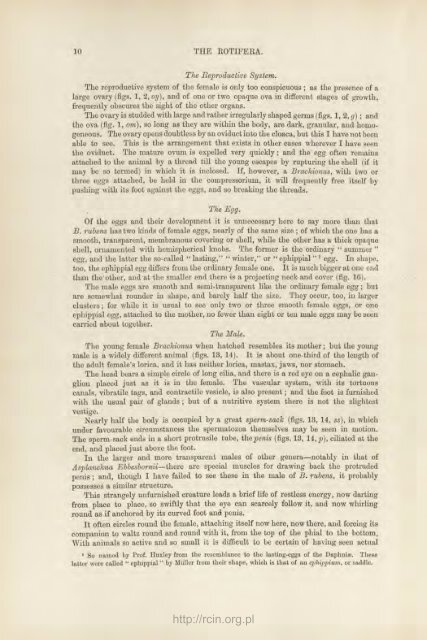You also want an ePaper? Increase the reach of your titles
YUMPU automatically turns print PDFs into web optimized ePapers that Google loves.
The Reproductive<br />
System.<br />
The reproductive system of <strong>the</strong> female is only too conspicuous ; as <strong>the</strong> presence of a<br />
large ovary (figs. 1, 2, oy), and of one or two opaque ova in different stages of growth,<br />
frequently obscures <strong>the</strong> sight of <strong>the</strong> o<strong>the</strong>r organs.<br />
The ovary is studded with large and ra<strong>the</strong>r irregularly shaped germs (figs. 1,2,0); and<br />
<strong>the</strong> ova (fig. 1, om), so long as <strong>the</strong>y are within <strong>the</strong> body, are dark, granular, and homogeneous.<br />
The ovary opens doubtless by an oviduct into <strong>the</strong> cloaca, but this I have not been<br />
able to see. This is <strong>the</strong> arrangement that exists in o<strong>the</strong>r cases wherever I have seen<br />
<strong>the</strong> oviduct. The mature ovum is expelled very quickly; and <strong>the</strong> egg often remains<br />
attached to <strong>the</strong> animal by a thread till <strong>the</strong> young escapes by rupturing <strong>the</strong> shell (if it<br />
may be so termed) in which it is inclosed. If, however, a Brachionus, with two or<br />
three eggs attached, be held in <strong>the</strong> compressorium, it will frequently free itself by<br />
pushing with its foot against <strong>the</strong> eggs, and so breaking <strong>the</strong> threads.<br />
The Egg.<br />
Of <strong>the</strong> eggs and <strong>the</strong>ir development it is unnecessary here to say more than that<br />
B. rubens has two kinds of female eggs, nearly of <strong>the</strong> same size ; of which <strong>the</strong> one has a<br />
smooth, transparent, membranous covering or shell, while <strong>the</strong> o<strong>the</strong>r has a thick opaque<br />
shell, ornamented with hemispherical knobs. The former is <strong>the</strong> ordinary " summer "<br />
egg, and <strong>the</strong> latter <strong>the</strong> so-called " lasting," " winter," or " epliippial " 1 egg. In shape,<br />
too, <strong>the</strong> epliippial egg differs from <strong>the</strong> ordinary female one. It is much bigger at one end<br />
than <strong>the</strong> o<strong>the</strong>r, and at <strong>the</strong> smaller end <strong>the</strong>re is a projecting neck and cover (fig. 16).<br />
The male eggs are smooth and semi-transparent like <strong>the</strong> ordinary female egg ; but<br />
are somewhat rounder in shape, and barely half <strong>the</strong> size. They occur, too, in larger<br />
clusters; for while it is usual to see only two or three smooth female eggs, or one<br />
epliippial egg, attached to <strong>the</strong> mo<strong>the</strong>r, no fewer than eight or ten male eggs may be seen<br />
carried about toge<strong>the</strong>r.<br />
The Male.<br />
The young female Brachionus when hatched resembles its mo<strong>the</strong>r; but <strong>the</strong> young<br />
male is a widely different animal (figs. IB, 14). It is about one-third of <strong>the</strong> length of<br />
<strong>the</strong> adult female's lorica, and it has nei<strong>the</strong>r lorica, mastax, jaws, nor stomach.<br />
The head bears a simple circle of long cilia, and <strong>the</strong>re is a red eye on a cephalic ganglion<br />
placed just as it is in <strong>the</strong> female. The vascular system, with its tortuous<br />
canals, vibratile tags, and contractile vesicle, is also present; and <strong>the</strong> foot is furnished<br />
with <strong>the</strong> usual pair of glands ; but of a nutritive system <strong>the</strong>re is not <strong>the</strong> slightest<br />
vestige.<br />
Nearly half <strong>the</strong> body is occupied by a great sperm-sack (figs. 13, 14, ss), in which<br />
under favourable circumstances <strong>the</strong> spermatozoa <strong>the</strong>mselves may be seen in motion.<br />
The sperm-sack ends in a short protrusile tube, <strong>the</strong> penis (figs. 13, 14, jo), ciliated at <strong>the</strong><br />
end, and placed just above <strong>the</strong> foot.<br />
In <strong>the</strong> larger and more transparent males of o<strong>the</strong>r genera—notably in that of<br />
Asplanchna Ebbesbornii—<strong>the</strong>re are special muscles for drawing back <strong>the</strong> protruded<br />
penis ; and, though I have failed to see <strong>the</strong>se in <strong>the</strong> male of B. rubens, it probably<br />
possesses a similar structure.<br />
This strangely unfurnished creature leads a brief life of restless energy, now darting<br />
from place to place, so swiftly that <strong>the</strong> eye can scarcely follow it, and now whirling<br />
round as if anchored by its curved foot and penis.<br />
It often circles round <strong>the</strong> female, attaching itself now here, now <strong>the</strong>re, and forcing its<br />
companion to waltz round and round with it, from <strong>the</strong> top of <strong>the</strong> phial to <strong>the</strong> bottom.<br />
With animals so active and so small it is difficult to be certain of having seen actual<br />
1 So named by Prof. Huxley from <strong>the</strong> resemblance to <strong>the</strong> lasting-eggs of <strong>the</strong> Daphnite. These<br />
latter were called " epliippial " by Miiller from <strong>the</strong>ir shape, which is that of an ephippium, or saddle.<br />
http://rcin.org.pl
















